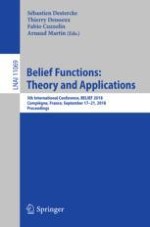2018 | Buch
Belief Functions: Theory and Applications
5th International Conference, BELIEF 2018, Compiègne, France, September 17-21, 2018, Proceedings
herausgegeben von: Sébastien Destercke, Prof. Thierry Denoeux, Dr. Fabio Cuzzolin, Arnaud Martin
Verlag: Springer International Publishing
Buchreihe : Lecture Notes in Computer Science
